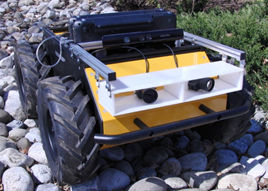![]() A Simulation-Framework for Generating Planning Logic for Autonomous Unmanned Ground Vehicles
A Simulation-Framework for Generating Planning Logic for Autonomous Unmanned Ground Vehicles
PI: Prof. S.K. Gupta
Currently most unmanned ground vehicles (UGVs) are tele-operated via a human or controlled autonomously with hand-coded software. As UGVs become more commonplace and are expected to operate with greater autonomy in more challenging and sometimes unknown environments, traditional methods of hand-coding the control and behavior logic become very costly for a number of different reasons. Many man-hours are required to craft robust logic, and there is increased probability that a critical mission will fail because of an unforeseen obstacle. The costs involved in rewriting and improving planning logic code for UGVs operating in the real world can be significant.
Working closely with the Simulation-Based System Design Laboratory at the University of Maryland, ETC has successfully shown that a viable alternative to producing vehicle logic by hand is to have the vehicle learn its own behaviors in a high-fidelity physical simulation environment. In the simulation, missions, obstacles, environmental factors, terrain, sensors, and vehicle parameters can all be modified with much greater speed than in the real physical world. Thus, a vehicle can rapidly be re-trained for a change in mission or engineering specifications. Additionally, because the simulation environment also allows vehicles and events to be driven by human operators, experts can verify the accuracy of the simulation, teach behaviors by demonstration, and compete against the machine-controlled vehicle.
The requirements for high simulation performance led the group to use the commercially available Vortex simulation library, developed by CMLabs. On top of Vortex, a customized framework for quickly changing the vehicle and environmental parameters was added.
Integrated with the simulation environment is an architecture for automatically generating software for vehicle operation via various machine learning (ML) techniques and testing it in the environment. A breakthrough in machine learning, developed by the team for these projects, involves combining genetic program- ming with automated identification and patching of failures to automatically synthesize behaviors encapsulated by decision trees.
The team has successfully demonstrated the use of ML to generate logic comparable to what would be hand-coded by a human programmer for two different behaviors. These behaviors were learned in simulation and the resulting logic was executed on a small RC vehicle modified for autonomous operation.
Continuing work will focus on applying the same techniques and tools to a larger, more capable vehicle platform with more complex behaviors. The pictured vehicle has been acquired and fitted with sensors to enable an autonomous operation. The additional sensors and the increased physical capabilities of the vehicle will allow for a much broader set of possible behaviors to be automated, using the same simulation and machine learning framework created for the past platform. This will serve to demonstrate that the theory behind the autonomous behavior generation can be applied equally well to larger platforms.

Vehicle with Computers, Kinect, and Cameras Mounted

